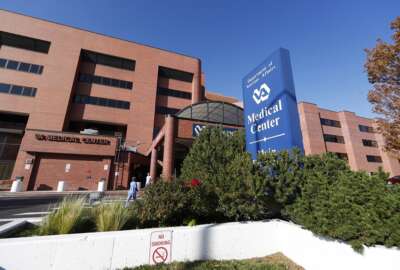Hubbard Radio Washington DC, LLC. All rights reserved. This website is not intended for users located within the European Economic Area.
Veterans Health Administration wins big award for surgical safety program
A VA program known as Surgical Pause received a national patient safety award. The Pause is a way of screening surgery patients with high risk of complications.
Even in the 21st century, surgery is never a routine matter. Recently, a Veterans Affairs program known as Surgical Pause received a national patient safety award. The Pause is a rapid way of screening surgery patients, who have a higher risk of complications. For the details, the Federal Drive with Tom Temin talked with two medical doctors from the VA Pittsburgh Healthcare System: Daniel Hall, a surgeon and Mark Wilson, National Director of Surgery.
Interview Transcript:
Tom Temin And let’s begin with surgical pause. What exactly is it and how did you come up with the idea?
Daniel Hall The idea originated in the Omaha VA medical center by a colleague of ours, Dr. Jason Johanning, who is a vascular surgeon who also has some training in geriatrics, and recognized that there was a real opportunity to develop a program to try to improve performance among the highest risk patients that we treat, who tend to be older and physiologically somewhat more frail. These are the kinds of people who are systematically excluded from the medical studies that we typically quote to our patients, to set their expectations for what is likely to occur after surgery. But what we know is that older frailer patients systematically experience outcomes that are not as good as we would hope for them. And that presented the opportunity by which we would try to identify them before we made the decision to operate, so that we could intervene early and try to improve their outcomes as much as possible.
Tom Temin So there are known factors that you kind of put together and then develop some kind of an analytical approach to it.
Daniel Hall Yeah. What we were able to do was develop a very brief patient facing survey, which we called the Risk Analysis Index or the RAI. It takes just about 30 seconds and we administer it to basically every patient coming to see a surgeon, so that we have that score in the surgeon’s hands at the time that they first meet that patient. And that signals to them in the 5 to 10% of cases where the risk is elevated, an opportunity to slow down and pay really close attention to those folks. Most people, they can treat exactly the way that they’ve always treated. They’re extremely efficient at trying to get people rapidly to the services that we know they will benefit from. But this allows them to sort of step away from that rapid assembly line kind of thinking and bring all of the experience that they have garnered over their careers to the people who can benefit from that most.
Tom Temin Well, what can you learn in 30 seconds?
Daniel Hall What you can learn from 30 seconds, at the threshold that we use it, we’re able to identify that portion of the population. It’s about the highest risk 10% of the patients that we treat with surgery who experience at least twice the rate of post-operative mortality, at least twice the rate of readmission after surgery, and at least twice the rate of long term ICU stays. Also increased the rates of long term loss of independence, by which mean people who come to surgery from an independent living environment at home, and then surgery becomes the occasion by which they transition into long term institutionalized living. In 30 seconds, we can have a good idea of who those people might be, and then we can step back and ask ourselves, are there any things that we can do to try to reduce that likelihood? And if so, we can do it, we also can step back and ask and make sure that the proposed treatment is really aligned with the patient’s goals. And some people will sort of say, thank you very much for making me aware of these downstream risks. I’d really prefer that you keep the scalpel in the drawer. Why don’t we try to pursue an alternate strategy for the pain that I have from my hernia for a period of time, because I really would like to avoid the downstream risks that you’ve just outlined for me.
Tom Temin Sure. And, Dr. Wilson, what do we know then about some of the outcomes? How are you measuring this program? What are the measures and what have you learned so far?
Mark Wilson The joint experiences, both in VA, at programs that have implemented, as well as private sector programs in community U.S. and overseas that have implemented have been significant reductions in all cause mortality following surgeries. So the awareness of surgeons regarding the patient risk and the opportunity to intervene, to optimize the patient, to best tolerate to surgery and have the best outcomes if they elect to proceed with the procedures, have really been demonstrated to be substantially improved from risk adjusted and other analysis of outcomes.
Tom Temin So in other words, aside from avoiding the surgery altogether, there are mitigating things that the surgeon can do knowing about this patient to maybe enhance the outcome.
Mark Wilson Both the surgeon and the care team, but also the patient themselves. In some cases, this discussion leads to review of risk factors that are within the patient’s control, that are modifiable, that would improve their individual outcome from the surgery. So it’s an opportunity to discuss with a patient both the aspects of the care team and what they provide to the patient, but also what the patient can elect to do for themselves to decrease risk associated with the procedures.
Tom Temin And how did this all get promulgated throughout the VA system? It sounds like something that’s probably easier to spread than, say, a new surgical technique, for example, where everyone would have to practice and prove they can do it. A 30 second survey sounds like something kind of easy to get everybody on board with.
Daniel Hall Easier than a brand new surgical procedure, but all culture change is hard. So I’ll speak to that a little bit. We’ve been very lucky and blessed to be practicing in the kind of environment that we do. Working with my colleague, Dr. Johanning, I was able to do the data analyzes to bring the high quality data that’s available to us in the VA to substantiate the claims that this very mild and brief intervention really does improve outcomes. I was also then able to use that data to increasingly characterize and describe what the nature of this risk is, and continue to share that information with the surgeons and other care providers and physicians in the interdisciplinary team, again, to build consensus and enthusiasm around it. We initially started by publishing the results in Pittsburgh, and it was really helpful to have national statured, peer reviewed publications that sort of confirmed that what we were seeing was real, and then replicated the results first at the Pittsburgh VA, and then in the private sector at the UPMC hospitals in Pittsburgh. Publishing those results as well garnered the attention of the Diffusion of Excellence program in the VA, which identified the surgical pause as one of the winners in their Shark Tank competition. It’s a little bit like the show that you see on TV, but they try to bring innovations from the field to a competition where directors of medical centers and health systems bid on particular programs. And I was lucky enough to have been selected as one of those winners we replicated at Iowa City. And that was right at the beginning of the pandemic, and there was still enough enthusiasm that diffusion of excellence assigned to the program, a implementation specialist who then helped us scale it across the nation. And over the last three years, we’ve been able to bring it to more than 50 VA medical centers across the nation, always as an opportunity for them to do the right thing. Not a heavy handed stick, you must comply. But here the data are so compelling, don’t you want to get involved? And that has culminated recently with the National Surgery Office adopting it formally as a quality program for continued support and dissemination across the nation.
Tom Temin And you’ve also gotten a national award outside of VA from something called the Joint Commission. And that sounds pretty prestigious.
Daniel Hall Yes, I’m thrilled by this. I describe it to my friends as it’s the Kennedy Center Award for policy wonks in health care. Dua Lipa and Mick Jagger will not be in the green room, but there will be a green room in July when we go and receive this award. But it’s a deep honor jointly awarded by the Joint Commission and the National Quality Forum, these are the two most influential national organizations that organize and shape the policy that hospitals and medical doctors work within, and they’ve been instrumental in improving the quality and outcomes in the United States writ large. So it’s a huge testimony to the innovation that myself and an enormous team of folks have been able to accomplish in a relatively short period of time.
Tom Temin It strikes me that Health and Human Services would want to even glom on to this, because they are the pair of so much surgery that is done in the private sector throughout the nation to almost slingshot this idea throughout the payE system that they regulate and oversee.
Daniel Hall From your mouth to those policymakers ears, please.
Tom Temin All right. And just a final question. It strikes me there might even be a psychological component to the outcomes with the patient knowing that extra attention or extra care knowledge on the part of the surgeon is present before they get that mask on and count backwards in sevens from 103, that somehow I’m in better hands than I thought I might have been.
Daniel Hall We have an enormous amount of qualitative data and quotations from both surgeons and their patients that testify to the fact that this is an opportunity and a way for them to be the doctors that they really want to be, and for patients to obtain the kind of care that they come to expect from the VA. It is so very clear that this allows us to really focus in on what the patients need most and help them feel, not just feel, but to demonstrate to them our commitment to outcomes that are truly aligned, to restoring them to full health and flourishing, rather than just doing procedures because a certain amount of anatomy can be rearranged. It’s a way to really ensure that the anatomy that we are rearranging is being rearranged, so that they can get about the things in their life that really make life worth living.
Mark Wilson And Dr. Wilson, anything to add?
Mark Wilson We’re excited to see that the programs of the VA for innovation are benefiting patients. So often we think about innovation as being focused toward providers or focused toward efficiencies in health care system. But this is an opportunity, an example in which the innovation ecosystem has been very clearly supportive of improving a patient’s outcomes and their perspectives.
Copyright © 2024 Federal News Network. All rights reserved. This website is not intended for users located within the European Economic Area.
Tom Temin
Tom Temin is host of the Federal Drive and has been providing insight on federal technology and management issues for more than 30 years.
Follow @tteminWFED





